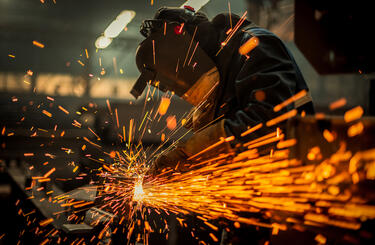
Welding: it’s time to clear the air
Progress indicator

Welding is key in many industries, but can endanger the workforce. George Assimacopoulos explains how quality professionals can help mitigate the risks.
The welding process is at the heart of industry. Ships, cars, trains, buildings, metal bridges, boilers, pipelines, offshore structures, to name just a few, all require welding during their construction, manufacture, repair and maintenance work.
As a result, many thousands of people around the world are involved in this work, exposing their health to potential dangers every day. These risks include radiation, noise, vibration, heat charge, electrical hazards, hazard from electromagnetic fields, risk of explosion and fire, danger from fume inhalation, falls, and ergonomic issues.
So what do quality professionals need to be aware of and how can we work to mitigate such risks in this field?
Risks from airborne contamination
In 2018, the International Agency for Research on Cancer (IARC) published Monographs Volume 118, in which welding fumes were evaluated and reclassified as Group 1, or carcinogenic to humans. Based on this assessment, IARC revised its evaluation of 1990 when it had classified welding fumes as “possibly carcinogenic” to humans (Group 2B).
The conclusion is that exposure to welding fumes increases the risk of lung cancer, regardless of the steel welded or the welding method used.
The International Institute of Welding (IIW) recommends that, to eliminate the excessive risk of lung cancer and potentially kidney cancer facing welders, both they and their managers must ensure that:
-
exposure to welding fumes is minimised, at least to national guidelines;
-
there is no exposure of welders to asbestos;
-
welders are encouraged and assisted to smoke no tobacco.
Additionally, IARC classified UV radiation from arc welding as carcinogenic, based on an increased risk of uveal melanoma in people working as welders that has been highlighted in a number of epidemiological studies.
Maintaining standards
When performed properly and with the right protection, welding is a safe occupation. Nevertheless, to maintain this industry, we, as quality professionals, must continuously be aware of the potential hygienic standards associated with fumes, gases and particle pollution created by the welding processes. We must also monitor welding filler metals, the base metals and their coatings and the shielding gases, as well as the welding conditions.
The use of uniform sampling procedures does not always guarantee identical experimental results, because the data is affected significantly by relatively minor differences in the local environment conditions. It can also be potentially affected by the welding process variables, the equipment and the procedures used for collecting and analysing contamination, the manner in which the results might be interpreted, and so on.
“To maintain this industry, we, as quality professionals, must continuously be aware of the potential hygienic standards associated with welding fumes, gases and particle pollution created by the welding processes.”
The quantity of fumes collected with a filter outside of the welder’s mask is influenced by the orientation of the welder in relation to the fume stream, local air currents, the rate at which fumes are produced, welding conditions, and so on. When fumes are collected with a filter located inside the welder’s mask, these same factors and their effect on the fume measurements have to be considered. Additionally, uncontrollable factors associated with the welder can affect the quantities of fumes generated and collected.
Care in sampling and analysing the various types of fumes produced during the welding process must be exercised too. The purpose of sampling has to be clearly defined so that the fumes samples of the appropriate size can be collected and the capabilities as well as the limitations of the analytical techniques used must also be recognised. The nature of the fume samples to allow the use of statistical treatment in interpreting data on welding fume characteristics is also an imperative.
Solving the problem
The problem presented by welding fumes and gases can mostly be solved in several ways:
-
education;
-
compliance to relevant standards;
-
good working conditions and practices;
-
the use of appropriate ventilation and protection.
Attention must be paid to the required ventilation levels of the working area, the welding processes used, the manner and rate at which fumes and gases are generated, the relationships between the fumes and gases produced, and the classifications of welding consumables. Also of importance is the biological/health influences introduced to the workforce, and the various methods to sample and analyse welding fumes and gases, as previously outlined.
Sophisticated analytical methods have been devised to determine the composition of welding fumes and gases, and particle size. For site measurements, simplified practical procedures can be used to detect the presence and amounts of specific elements and components in the welding environment.
This is to ensure that harmful constituents are not present in hygienically significant amounts and also to verify the effectiveness of existing protection systems.
Controlled protection can be provided by a combination of local exhaust ventilation systems and respiratory protective equipment such as automatic darkening masks with integrated pumps of filtered air or, for very toxic environments, an air supply. It is also important to ensure continual verification and revaluation of the working environment by the use of risk assessment tools.
It is advised to try keeping exposure levels below the threshold limit values or workplace exposure limits as much as practically possible.
BAM Nuttall: Taking construction online
A detailed look into how the quality team at the construction and civil engineering company, BAM Nuttall, worked to incorporate technology and digital integration using Quality 4.0.
Become a member
Take your quality career to the next level by becoming a member of the CQI or an IRCA Certificated Auditor.
Find a CPD course
Develop your quality skills and knowledge with an approved CPD course.